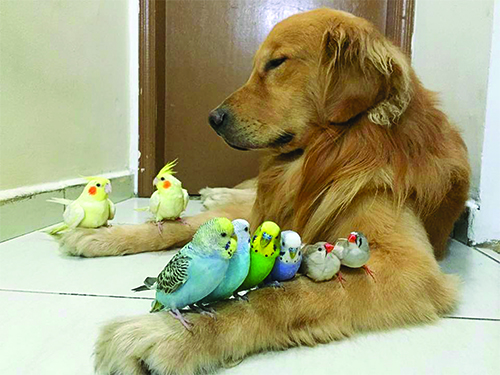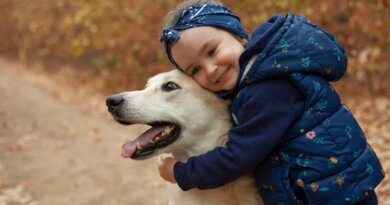Keeping the Peace in a Multi-Species Household

When you think about it, it’s a bit of a miracle that animals who would be predator and prey in many environments are often able to live peacefully together in our homes. How does this happen?
Sometimes it just happens, thanks to good luck, but more often it’s a result of careful planning and introduction. Throw in some good behavior modification, and we can improve the odds of a peaceful coexistence well beyond mere chance.
THE CHALLENGE
We know that our dogs are predators – and some certainly seem to be more predatory than others. This is a nature/nurture thing – partly due to genetics and partly due to environment.
Some dog breeds have been genetically programmed to find predatory behavior highly reinforcing. Think of all the various terriers, bred to kill rats and other vermin on a farm. Think of the hounds, bred to chase and kill a variety of different species for the hunter who follows. Then there are the spaniels, setters, and retrievers, bred to locate, indicate, and flush game for the hunter, and retrieve that game gently, with a very soft mouth after it has been killed by the hunter. The herding breeds are supposed to utilize the stalking piece of the predatory sequence but are never supposed to kill the stock they are herding.
Still, there are Jack Russell Terriers who live in harmony with cats and parakeets. Just because a dog has a genetic propensity to find a behavior reinforcing doesn’t mean he will actually engage in the behavior. The terrier who has never been given the opportunity to chase and kill small animals has probably never had the behavior reinforced. If he was well-managed since puppyhood and grew up learning how to behave appropriately around cats and birds in his home, he would never learn that it was fun to chase and kill small animals, so he doesn’t. (It also helps if the cats and birds in his house have grown up with and are calm around dogs, so they don’t offer behaviors that might trigger a chase response in typical Jack Russells.)
Meanwhile, there are Australian Shepherds – dogs who have been genetically programmed to gather and keep track of cattle and sheep without hurting one – who will eagerly chase and kill bunnies.
As you go forward with a plan to integrate your household with a variety of animal species, keep in mind that, even though they share your sofa and Starbucks habit, deep down, dogs are still predators. If given the opportunity to learn that killing bunnies or cats is fun, many of them will enjoy doing it, even if they don’t have a strong genetic propensity to find the behavior reinforcing.
All else being equal, it will likely be easier to convince your Aussie to live peacefully with small animals than your JRT, but both breeds (and representatives of every other breed) can learn to do it, too.
GREAT STARTS
The easiest way to create interspecies household harmony is to start with a puppy and carefully manage her interactions with other animals as she matures. If she is consistently reinforced for calm behavior in their presence and not allowed to play roughly with them (rough play can turn deadly), she will come to see them as family members and learn to be calm with them.
In theory, it’s simple, yet it can take a lot of management and training for some pups to reach maturity with a “small animals are my friends” world view. Until she learns impulse control, your pup needs to be on-leash in the presence of other small animals in your household, so she doesn’t have the opportunity to perceive them as animated stuffed toys.
If, despite your precautions, it appears your pup has an unhealthy interest in the creatures around her, you’ll need to pursue some of the behavior modification protocols that follow, and if necessary, seek the assistance of a qualified force-free professional.
From the other side, it is just as useful to start young with your “other” species, introducing them to dogs early in their lives, and making sure they have good experiences with canines of various shapes and sizes. A positive association with dogs from early on will reduce stress and make adjustment easier for them when you bring a new predator into the home.

INTRODUCING A NEW DOG
Whether you’re bringing a new puppy, an adolescent, or an adult dog into your multi-species home, it behooves you to orchestrate careful introductions to set the stage for a future peaceful co-existence.
- Ask for information, but take it with a grain of salt. It helps if you have any history about your adopted adolescent or adult dog’s prior relationships with other species – but don’t rely on the information. Several years ago, some of my clients were assured by a rescue group that the adult German Shepherd Dog they were adopting had lived compatibly with cats. The dog’s ability to do so in their home, however, required several months of dedicated management and behavior modification work (see “Transformation: Predator to Pal,” WDJ July 2013). Even shelters that include dog-dog and/or dog-cat introductions during their assessment processes can’t guarantee that your newly adopted dog will behave the same with other animals in your home as she did at the shelter.
- Set up for success. Before you first bring your new family member into the house, shut away all your other animal companions. Your new dog will likely be stressed from the journey – and remember, even happy excitement causes physiological stress. Give her time to settle down before upsetting her applecart again.
If she seems excessively stressed by the change in her life fortunes, don’t even attempt any introductions on the first day. You don’t need to add that level of stress to the early relationship-building process. If, on the other hand, she seems cool, calm, and collected, then you can proceed after a reasonable cool-down period of maybe an hour or two.
- Don’t mistake stressed, shut-down behavior for calm. If you aren’t skilled at assessing canine body language, have someone who has more dog experience with you (see “Listen By Looking,” August 2011). Either way, you’ll want to have a second person with you for the introductions, to manage the other animals, and in case things go wrong and you need help separating animals.
- Keep contained. With one of you safely holding the new dog on leash, bring in one other animal, also safely contained in some manner – in a cage or carrier, or on leash – and watch your new dog’s body language very closely. Your dog’s ideal response is interested and calm.
- Go slow! For this first encounter, your goal is for the two animals to be in each other’s presence without either one getting overly stressed or excited. Keep them as far apart as necessary to accomplish this, and feed treats if necessary, to help each calm down or be less stressed. Even if things go well, do not try to bring them nose-to-nose on the first meeting. Err on the side of caution. You’ve got plenty of time to help them be best buddies – or at least to live in peace.
Gradually, over a period of days, weeks, or even months, bring them closer together and allow more intimate contact, while still using uber-management to make sure only good things happen. If you have several other animals, use your good judgment about how often and how many introductions you do at any given time or in any given period.
Depending on your results, you may be able to relax management fairly quickly, or you may need to keep some management in place forever. Dog and cats frequently become compatible housemates with no management needed. Other small companion animals may need more protection from your canine predator, especially when you aren’t present. Provide multiple escape routes for your small pets, whatever your ultimate level of management.
INTRODUCING A NEW PET TO YOUR “OLD DOG”
Perhaps your dog is a long-term family member, and the new family member in your home is another type of animal. You probably have a better idea of what your dog’s response is likely to be (calm and non-predatory, we hope!), but you still want to give your new pet plenty of time and space to adjust to the idea of living with a predator. Your introduction will be similar to that described above, but in this case, you’ll be paying even more attention to the newcomer, gauging his reaction to his new life situation.
If you are not already familiar with the body-language communication of the new species, be sure to research it well in advance. The less domesticated/more exotic the species, the more likely they are to do a freeze/shut-down response in the presence of a predator, and the easier it is to make a tragic mistake and misinterpret this as calm and relaxed.
INTRODUCING LARGE COMPANION ANIMALS
We tend to think of small animals when we talk about introducing our dogs to new family members, but there are plenty of canines who share their living spaces (indoors and out) with large animals such as pigs, goats, sheep, llamas, emus, horses, and more.
Introductions to these animals, whether the dog is new or the other species is new, is every bit as important as the small pets. Keep in mind that your dog might be the more vulnerable species in some of these relationships (since a horse’s kick or stomp can easily kill a dog, and even a cranky pet pig or llama can hurt an unwary pup).
Your introduction process is much the same as described above – moving more quickly through the procedure if things go smoothly, more slowly if not, and doing behavior modification if necessary.
Consider additional factors inherent with large animals; management alone might be realistic for a dog who doesn’t do well with horses – maybe you just never take her to the barn. However, if you have a miniature house-pig, or a miniature horse working as your service animal, you’ll need to do the work to get them all comfortable and well-behaved together.
BEHAVIOR MODIFICATION
If the challenge looks surmountable and you’re willing to do the work, get started immediately.
- Have the whole family participate in the discussion and agree on the rules for management. Consider padlocks for doors if there are small children in the home who will have difficulty complying despite their good intentions. Develop communications systems so it is clear which companion animals are where and when. No “oops” allowed; someone’s life may depend on it.
- Discuss and agree on which behavior modification protocols will be used. My first choice is usually counter-conditioning and desensitization (CC&D; see next page for step-by-step instructions). Constructional Aggression Treatment (CAT) and/or Behavior Adjustment Training (BAT) are other protocols that can be useful. (For more information about both protocols, see “Fear Aggression in Dogs,” WDJ August 2016.) Seriously consider bringing in a qualified force-free professional to help you with these, especially if you are not familiar and experienced with the protocols.
- Basic training. Every dog should be the graduate of at least one basic good manners class (and of course, puppies should go to puppy kindergarten!). The communication and relationship achieved between dog and human through training will be invaluable in sorting out your inter-species relationships.
WORTH THE EFFORT
Whether it takes days, weeks or months to accomplish a reasonable degree of inter-species tranquility, it can be well worth the effort. I know how greatly my own life has been enriched by sharing my home and my heart with well over a dozen different species of animals over the years, for many years more than 20 animal companions at a time. It wasn’t always easy, but it was always worth it.




